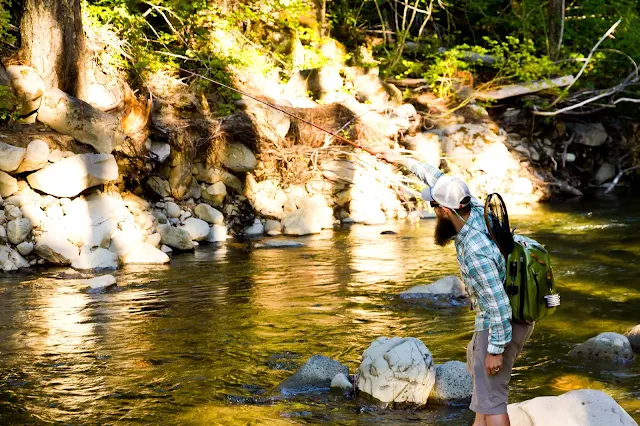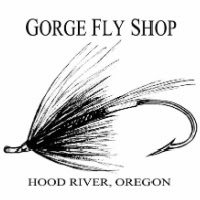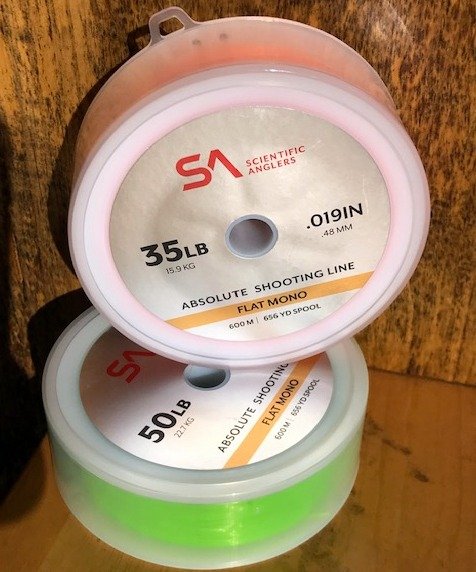Ever had a fly box full of water?
Ever had your extra change of clothes get soaking wet?
Ever ruin a phone or camera with an accidental spill or drenching rain?
Ever had your PB&J get soggy but you're so hungry that you eat it anyway?
 |
| Perfect for Wet Wading |
There are a lot of waterproof packs to choose from these days. So many so that it can difficult to choose a winner. Luckily I have all of them here in the shop to play with and pour over.
After much debate and ridicule from coworkers as I struggled to figure out how each bag was made to be worn, I settled on the Fishpond Thunderhead Sling.
These are the key features that stuck out to me:
- Fully waterproof zippered large compartment
- TIZIP® submersible zipper
- Durable TPU welded fabric
- Tons of attachment points, d rings and pull loops
- Net sleeve
- Comfortable, adjustable, easy to swing around
- External water resistant quick access pocket

The simplicity of the design is also something that I greatly appreciated. There aren't a million little pockets and compartments for things to get lost in and it makes loading/unloading the bag a breeze. The large compartment also gives me the piece of mind to take my DSLR and an extra lens while I wade without worrying about ruining it. The simplicity also means the pack is light; which after a long day of fishing makes a huge difference on the back and shoulders.
 |
| Thunderhead is right at home on the Olympic Peninsula (and my beautiful wife sure makes it look good!) |
Versatility is the name of the game with the Thunderhead: High mountain trout streams one day, waterfall hiking the next, and swinging for steelhead the day after that! It has become my go-to day pack and my wife has tried to lay claim to it as her favorite hiking pack... from my cold dead hands! I also used this pack for a week straight in Disney World schlepping around my camera, lenses, phone, wallet and my wife and daughter's junk. I was able to take my valuables with me on every water ride!
The wide shoulder strap and simple buckles and adjustments make the Thunderhead easy to use and comfortable all day, even heavily loaded. The 2 quick release buckles make access and removal easy. You will notice quite a few orange TPU pull tabs spread out on the bag. At first you may think they are randomly placed, but after a few days of use you quickly find that each loop was put there for a reason. The loops at the top and the bottom of the bag are the most important as they allow you to pull hard on the TIZIP zipper, which needs some leverage to open and close. The loops are strong and well made and will certainly last the life of this bag.
There are two small pockets on the Thunderhead: one clear pocket inside for small items like tippet, leaders, knife, etc and one outside with a water resistant zipper external pocket, which I like to put my phone in when it isn't raining and I won't likely take a big spill in the drink. It is also handy for putting your wallet/license/small fly box in.
There are numerous tool attachment points on the Thunderhead. The tube shaped ones are designed for the Fishpond Swivel Retractor and Barracuda Clippers, and it works perfectly with those items. I have also attached the Fishpond Floatant Bottle Holder and Dry Shake Holder to the front strap d-ring for easy access. To the back d-ring I setup my old Fishpond tippet holder, but the Headgate Tippet Holder would work just as well, is easier to load, and has a built in line cutter. What I really like about this setup is I can take these items off quickly to convert it to a steelheading bag, daybag, or for hiking.
The final major feature in the Thunderhead and a number of other Fishpond bags is the net holster. It is an angled sleeve that is in the back pad of the bag. I finally have a way of bringing a big net with me that isn't totally cumbersome. I can get the Fishpond mid length boat net in there and carry it around all day without it getting in the way. I also love it for my smaller trout nets as it keeps them from banging around and getting caught on every branch as I bushwhack. It fits every net I have tried in it, and I barely notice it in there when it's holstered.
Some sling packs are a pain to use and often require you to just take it off to access the pockets. I can say that the Thunderhead is not one of those slings. One easy to use buckle, a quick slide around your torso using those pull loops and you have easy access to the large and small pocket, all of your tools, your tippet and anything else you attach to the bag. If you haven't tried a sling pack, or are looking for a way to keep your gear dry but easily accessible, the Thunderhead certainly fits the bill.
The bottom line is the Thunderhead is, in my opinion, the best waterproof sling bag on the market!
There are two small pockets on the Thunderhead: one clear pocket inside for small items like tippet, leaders, knife, etc and one outside with a water resistant zipper external pocket, which I like to put my phone in when it isn't raining and I won't likely take a big spill in the drink. It is also handy for putting your wallet/license/small fly box in.
There are numerous tool attachment points on the Thunderhead. The tube shaped ones are designed for the Fishpond Swivel Retractor and Barracuda Clippers, and it works perfectly with those items. I have also attached the Fishpond Floatant Bottle Holder and Dry Shake Holder to the front strap d-ring for easy access. To the back d-ring I setup my old Fishpond tippet holder, but the Headgate Tippet Holder would work just as well, is easier to load, and has a built in line cutter. What I really like about this setup is I can take these items off quickly to convert it to a steelheading bag, daybag, or for hiking.
 |
| Fully Loaded! |
Some sling packs are a pain to use and often require you to just take it off to access the pockets. I can say that the Thunderhead is not one of those slings. One easy to use buckle, a quick slide around your torso using those pull loops and you have easy access to the large and small pocket, all of your tools, your tippet and anything else you attach to the bag. If you haven't tried a sling pack, or are looking for a way to keep your gear dry but easily accessible, the Thunderhead certainly fits the bill.
The bottom line is the Thunderhead is, in my opinion, the best waterproof sling bag on the market!
The Bearded Pescador

Ryan Van Duzor
Gorge Fly Shop | Product Specialist
541.386.6977
Read More from the "Bearded Pescador"

















































